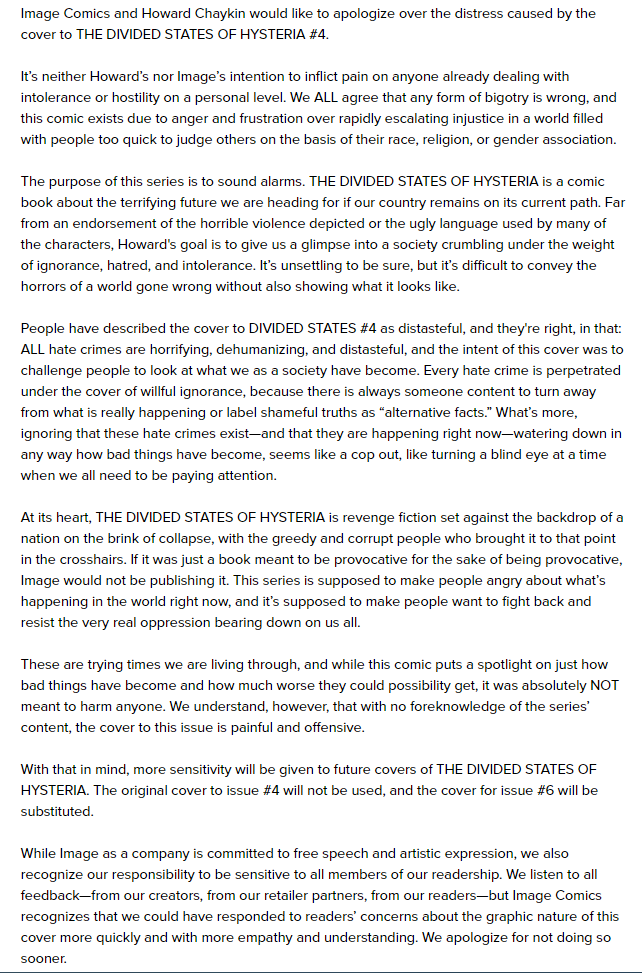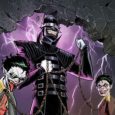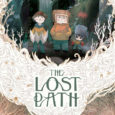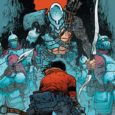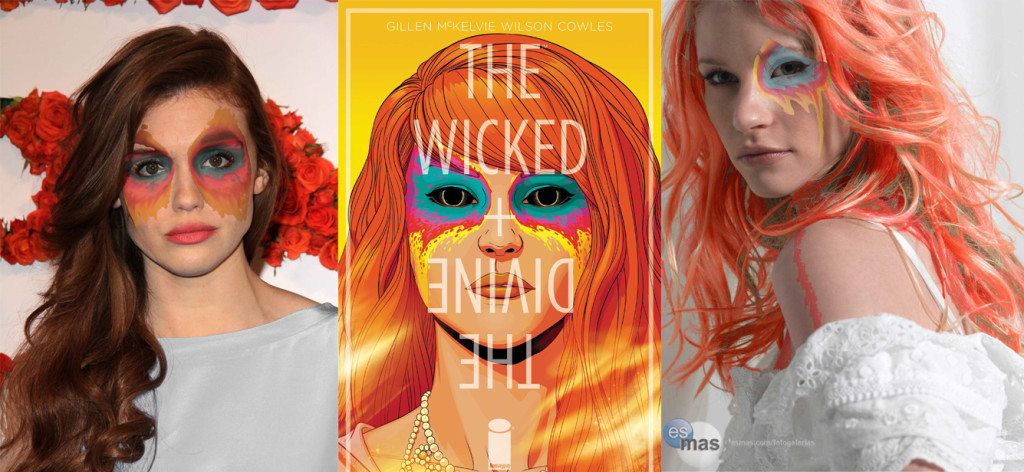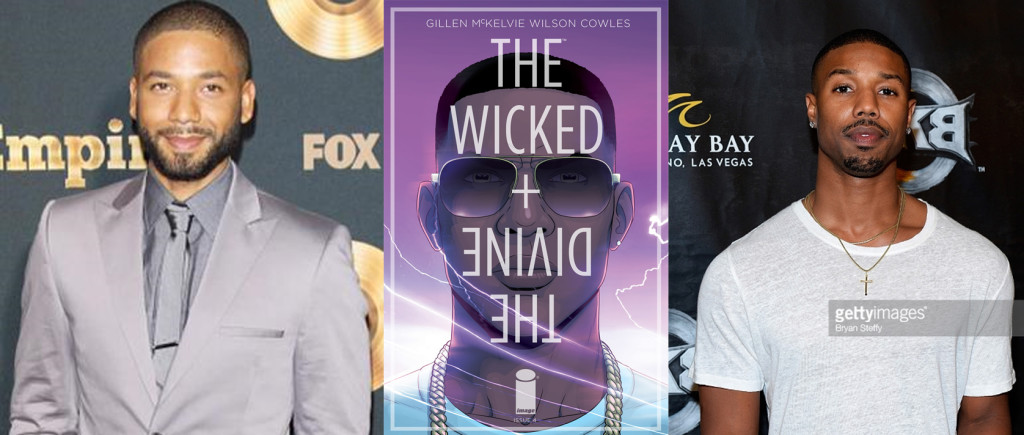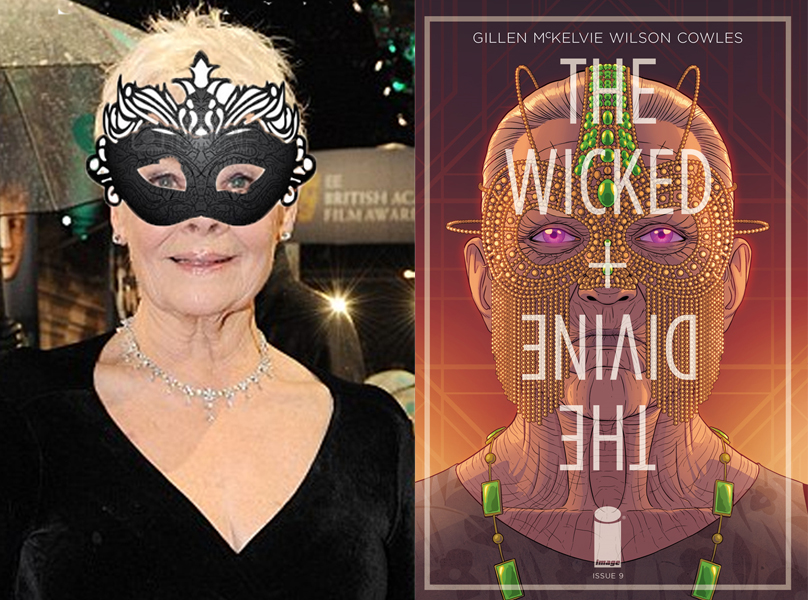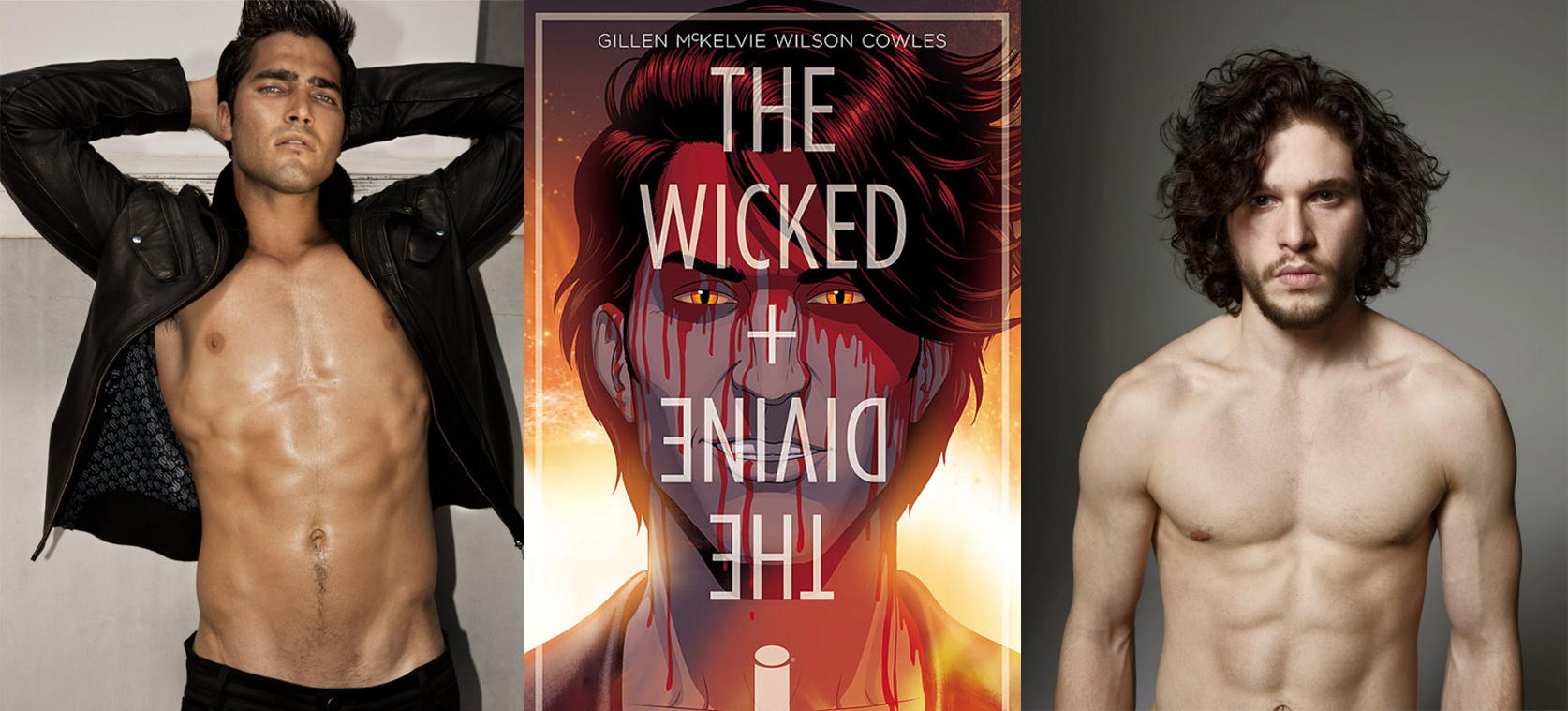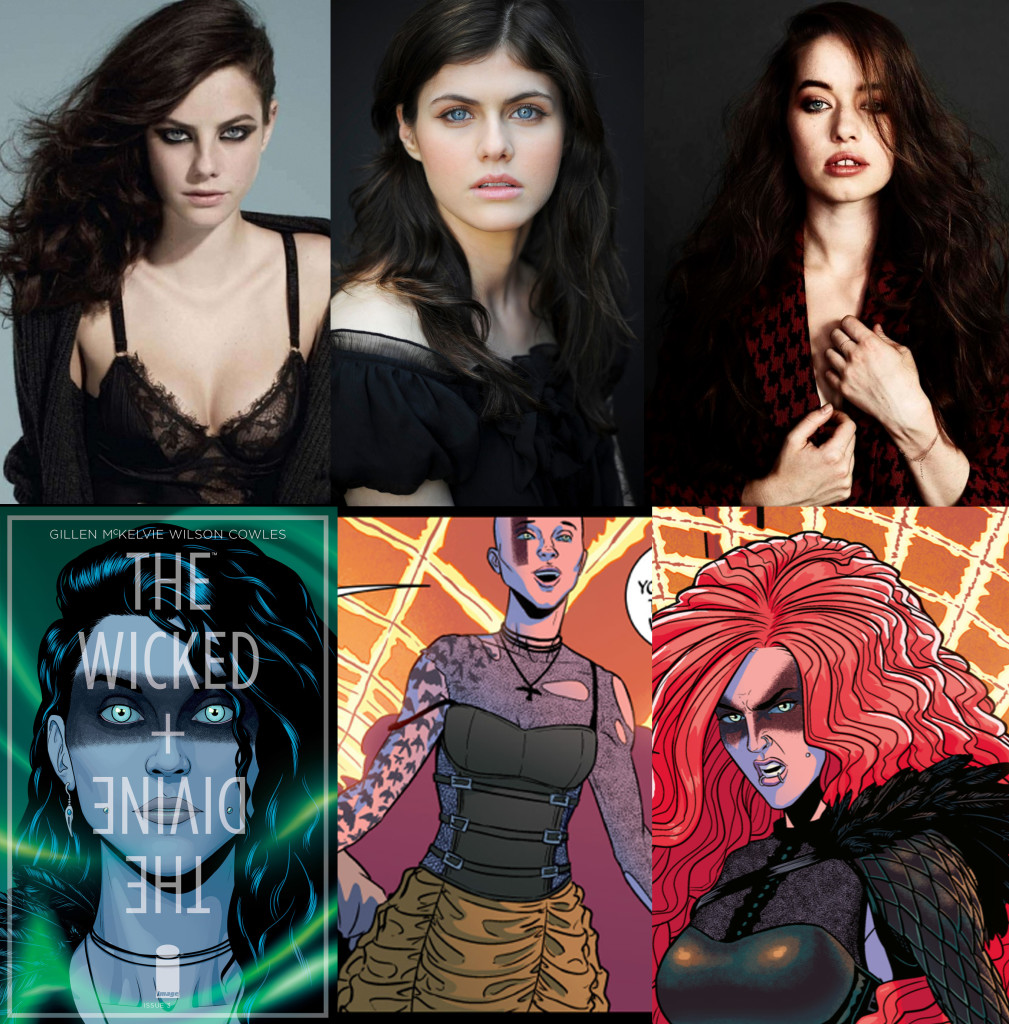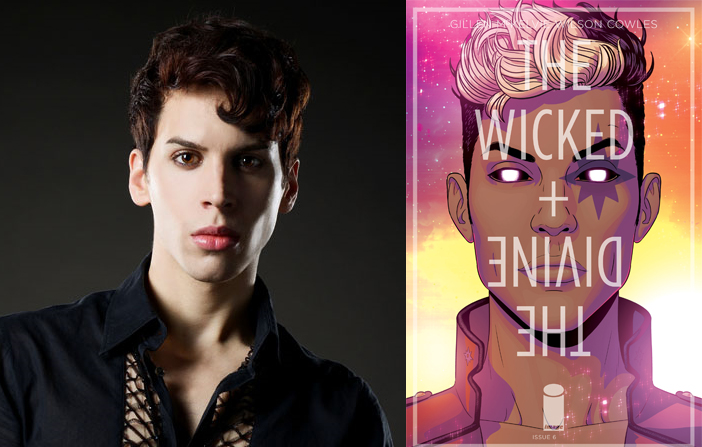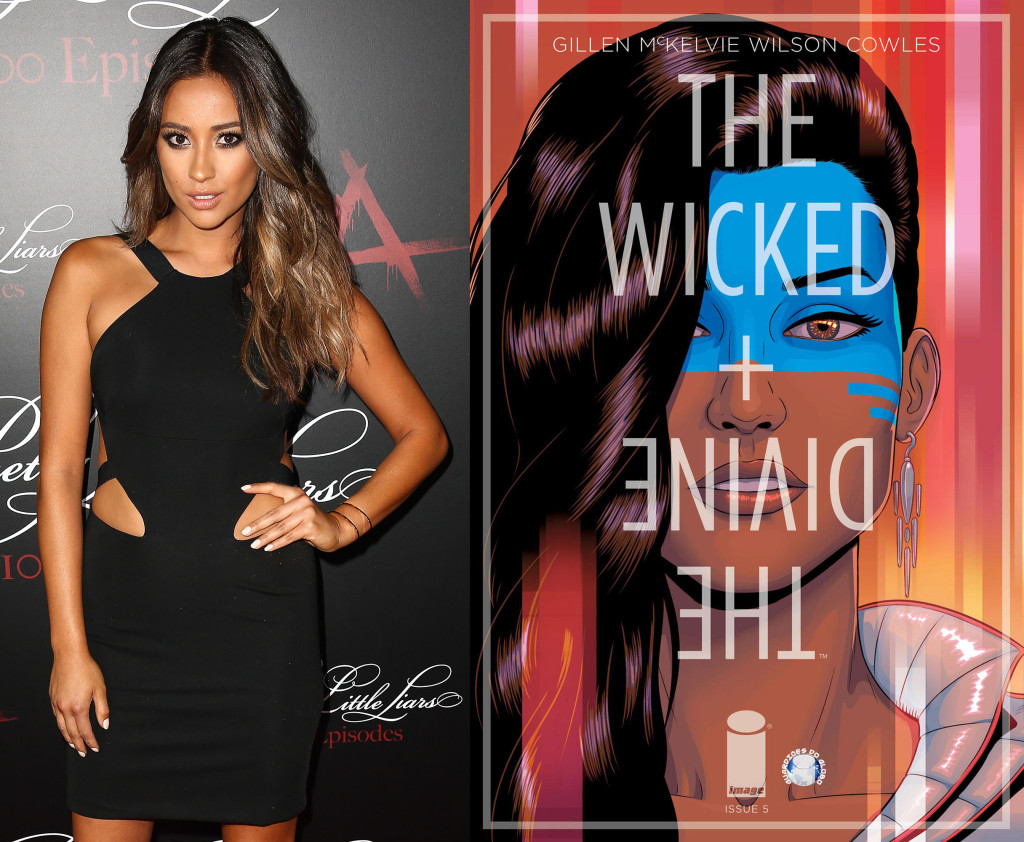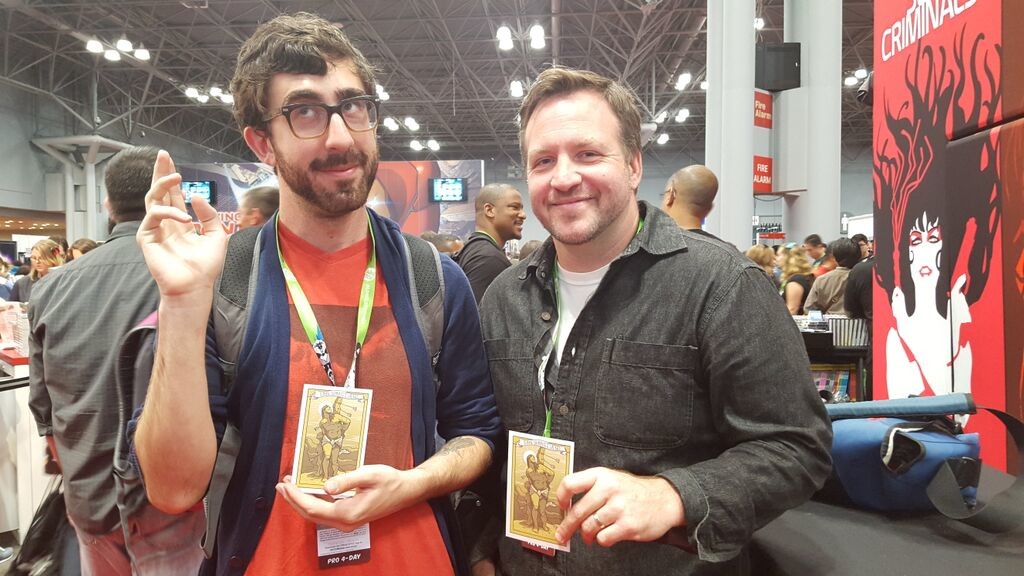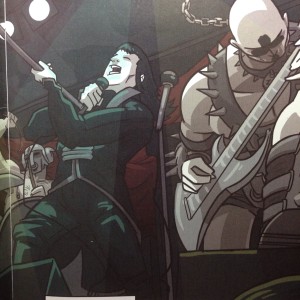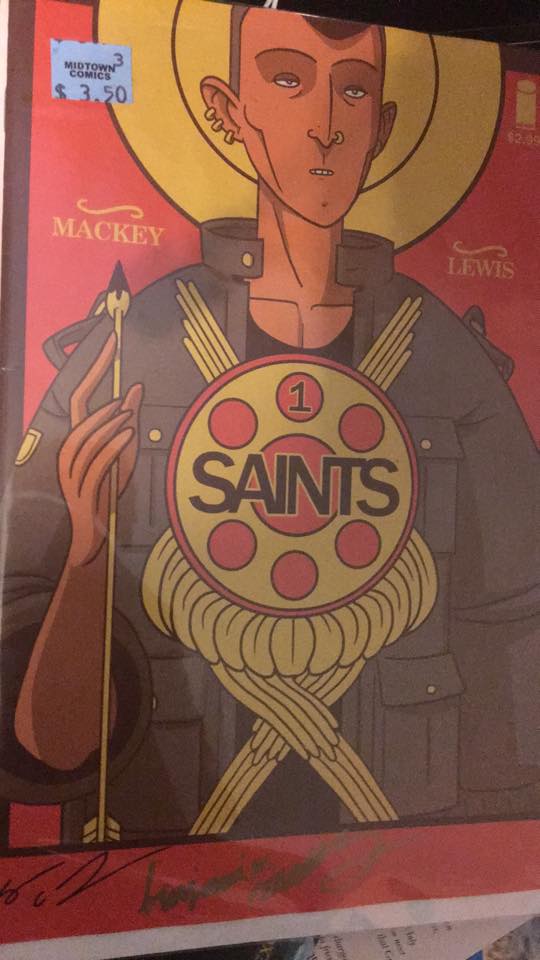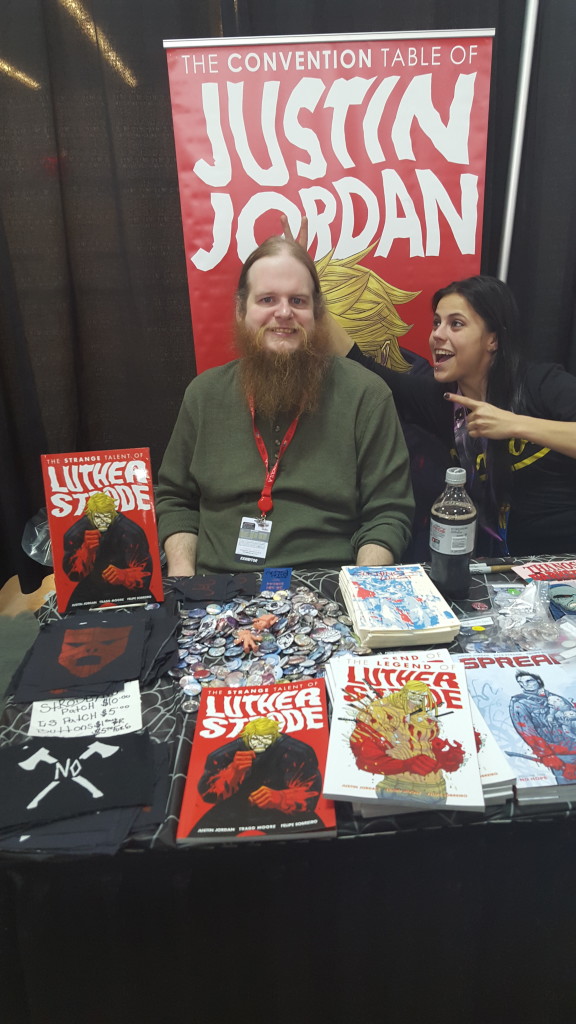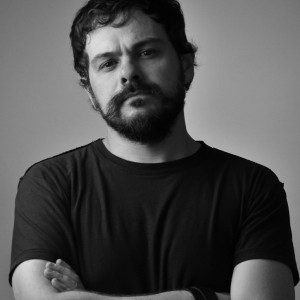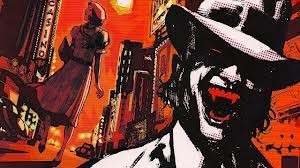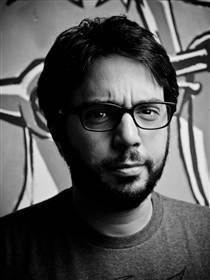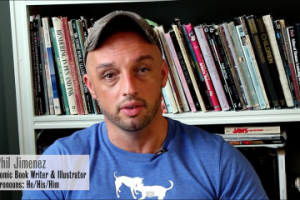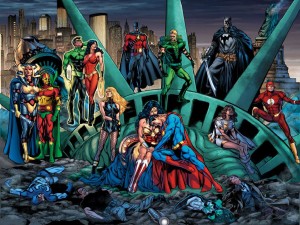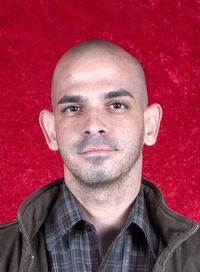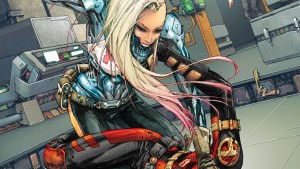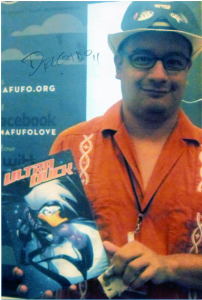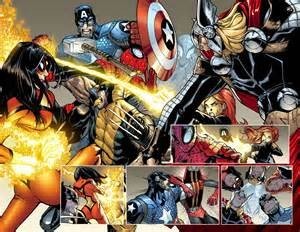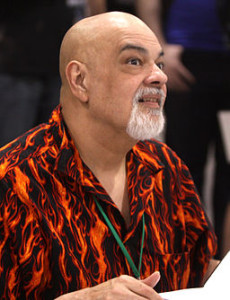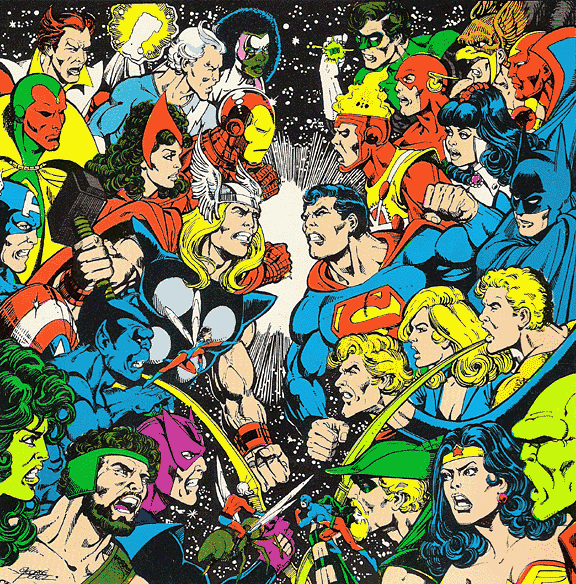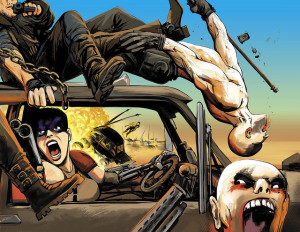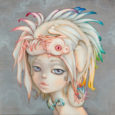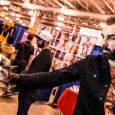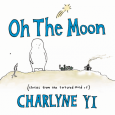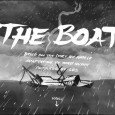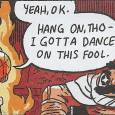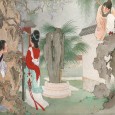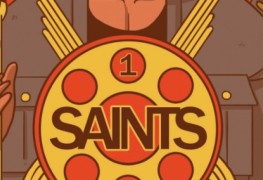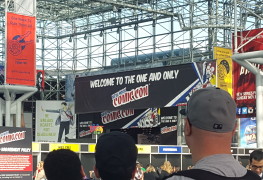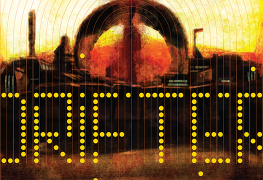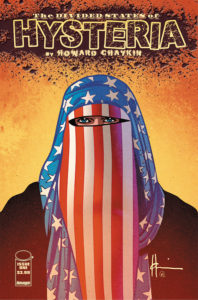 There’s been a lot of talk about boycotting Image Comics over the past two weeks. Those feelings are valid. I feel them too. However, I want to address why this would not work and open up the conversation to alternative courses of action. I’ll discuss what led readers to this decision, how Image makes their money, who a boycott will actually hurt, and ultimately what we can do together to help change happen.
There’s been a lot of talk about boycotting Image Comics over the past two weeks. Those feelings are valid. I feel them too. However, I want to address why this would not work and open up the conversation to alternative courses of action. I’ll discuss what led readers to this decision, how Image makes their money, who a boycott will actually hurt, and ultimately what we can do together to help change happen.
A SERIES OF UNFORTUNATELY SHITTY EVENTS
By now, we have all seen the cover to The Divided States of Hysteria #4, the latest title by longtime comic creator, Howard Chaykin. If you haven’t, here is a link to it, but I do warn you: it’s fucked up. From the racial slur to the mutilation, there’s nothing that sits right about this cover. As Comicosity put it:
“There’s nothing thought-provoking about the lynching depicted on the cover of issue #4. Chaykin chose to put a racial slur on the dead man’s name tag. Not spray painted on the wall by him, not written on him in blood. On his name tag. Chaykin decided that the value of the life of the victim he was portraying was so little that he didn’t even deserve an actual name. Just a slur.”
(If you’re pretty up to date on the events surrounding this cover, you can skip down to subsection “THE CALL TO BOYCOTT.”)
This is the latest in a quick series of affronts to marginalized readers regarding this title.
For one thing, The Divided States of Hysteria is a story about “an America shattered by greed and racism, violence and fear, nihilism and tragedy.” While not an intrinsically terrible premise, the writing itself is problematic. Chaykin’s characters use transphobic language in the very first issue while enacting violence against a transgendered sex worker named Chrissie. Transgender individuals already face heightened chances of violence according to a recent study, so why punch down on a group that experiences this as a fact of life?
Secondly, while the title isn’t the first to use this incendiary sort of story telling, having it released during Pride month is tone-deaf at the very least. Image Comics did such a huge promotion for its Pride variants, even releasing one starring Chrissie, that this felt like a slap in the face to the LGBTQIA community. It instead renders the gesture empty, making it a venture capitalizing on struggles we face daily.
Then, when first pressed for comment, Image declined. At this, most people curled their lip and readers were vocal about using their money to support books by other publishers instead. The outrage simmered down after a few days.
Most recently, Image released solicitations, or previews for upcoming issues which feature cover art, for The Divided States of Hysteria #4, as mentioned above. In the aftermath of a slew of rightfully angered comments, tweets, and emails, Image and Chaykin finally issued a statement:
There’s several questions that still need to be answered: Can we do anything as readers? How do these comics get approved when comics are such a collaborative medium, requiring many eyes before the book reaches the shelf? How can we stop supporting a publisher who lets this thing slide?
 LET’S TALK ABOUT IMAGE COMICS
LET’S TALK ABOUT IMAGE COMICS
Image Comics was originally created to represent creators who weren’t being appreciated by DC and Marvel for their work back in the early 1990s. In addition to a different business model, namely taking a fixed fee upon publication for the company’s administrative costs in exchange for the creator keeping all creative rights to their property, Image also doesn’t generally interfere creatively. Every comic published by Image lists their entire staff, right there in the masthead. There is no editorial staff, unless the creators themselves hire one, directly out-of-pocket. I spoke to a creator, who chose to remain anonymous, a little more about how this works:
“…to the best of my knowledge, no one looks at the files until the book goes into actual production. Now, this wouldn’t be true for things like covers, which are used for promo and marketing, but content wise there aren’t any checks on stuff that I’m aware.”
For a publisher that prides itself on being diverse, why isn’t more care given to the stories published? It could be because most creators behind current Image titles are predominantly cisgendered white males. It could be because publishers have consistently capitalized on minority experiences instead of celebrating them. Either way, for a supposedly “progressive” leader in independent comics, it’s a handful of specific creators that have made Image seem so forward-thinking. Image is progressive by default, when you compare them to the constant missteps by both DC and Marvel, and consider that a lot of newer readers enter the comic world through the award-winning Saga.
Overall, Image might have this reputation for being alternative and a breath of fresh air in the grand lineup of superhero books, but when you scrutinize the teams behind the books, it really isn’t. It’s hard to forget they’re a company who first and foremost want to make money. This is where readers come in.
THE CALL TO BOYCOTT
While I am certainly not going to tell anyone not to boycott, I do feel it’s my duty as a retailer to lay out why a blanket boycott will hurt brick and mortar shops without impacting the publisher itself. I stress that it’s very different to boycott a creator whose work you don’t care for versus an entire publisher.
Why does a blanket boycott hurt shops and not the publisher? A shop has to pay for comics about three months before they hit shelves. This means the publisher has already been paid, usually before reviews have come out, and before the public at large learns of the book. This is why a Previews catalogue is so important: it highlights upcoming books from all publishers, toys, shirts, merchandise, you name it. You can sign up and preorder anything in that catalogue at your local comic shop. And you should– that way shops can order the correct amounts of new product for their individual shelves.
Otherwise… shops have to take a guess. Some shops employ POS systems that track every bar code that goes out the door, and some do it all by paper and pencil, which works great for titles that have already come out and have an established fanbase. For new titles, we have to essentially wing it and put faith into it without having read it, in the hopes that it will sell. This is a much easier bet to make for bigger publishers like Marvel, DC, and Image than it is for smaller publishers.
Where a large corporation can handle a boycott by laying off people or raising the price of a product to offset the money lost, Image would have to cancel titles. It wouldn’t be titles like The Walking Dead either, it’d be the ones with smaller, dedicated fanbases that may not have high print numbers.
I asked my creator friend about this as well:
“It’s for sure going to hurt shops first and more. As you know, comic shops are buying stuff non returnably. So if, say, the entire customer base of a store decided at once to stop buying Image (or any other publisher) while the shop could adjust for future orders, they’re stuck with the stock they have. And stores, typically, have a lot less margin for that sort of thing than publisher.
In the specific case of Image, the next person up the chain, in terms of being hurt, are the creative teams. Image doesn’t profit off singles, and they only profit a little off of the rest. It’s hypothetically possible enough boycotting could reduce the number of titles they have and hurt them financially like that, or hurt trade enough, but by nature of the comics market and the Image model, you’re always going to be preferentially hurting shops and creators.
A boycott that was actually effective would hurt marginal titles most. Saga can lose 50% of it’s audience and still be profitable. The Few couldn’t.”
So, what can we do?
PATHS OF ACTION
Be vocal about why you’re not purchasing a book in as many places as you feel comfortable. Utilize hashtags, tag the publisher, tweet about what you are purchasing instead! You can launch a movement with peers and use the tools at your disposal to bring attention to the issue at hand, much like people did with Milo Whatshisface’s book under Simon & Schuster. Maybe it’ll be canceled and maybe it won’t be. There’s not a precedent for that exactly, but we can chalk that up to being disorganized about how we have been going about this. There’s also a wider range of representation happening than ever before, and until the creators ARE the people represented, there’s bound to be mistakes here and there. As long as there’s an honest conversation, progress can be made.
It shouldn’t fall on readers, both new and old, to constantly strive for change when it should come from within the industry. The same old white creators with the same old ideas should be encouraged to use their reputation and clout to fill their teams with people of color, women, queer people.
Whatever you do, DO NOT tag and/or attack the creator in your missives. Even if they’re the actual worst, they’re still people at the end of the day.
Focus on individual titles, look up your favorite creators and support their endeavors, either by buying their other work at a convention, commissioning a piece of art, signing up for their patreon, etc. Don’t be afraid to vote with your dollar.
It’s time for the comics industry to stop failing us. Us being retailers, readers, creators. Let’s stop pushing away a new, hungry readership and welcome them by listening. Hire qualified younger people who can point out things that may be easily missed. Get consultants on books if a publisher insists that same old creator writes a character with vastly different life experiences. Hell, just take a lap around a convention’s artist alley and take it in. See what people are buying and are excited about. These are new readers. These are people barely getting into books. These are seasoned fans reaching for something new. Yes, even the women ogling everything Kevin Wada has on sale. Yes, even the dudes purchasing J. Scott Campbell prints. Yes, even the queer people picking up that hard to find Pop figure. Yes, even the children standing in line to get a photo with Stan Lee.
Let’s do this together.
In case it’s somehow slipped your comic reading radar, The Wicked + The Divine is one of the top selling Image comics in the past two years. From the amazing creative collaboration between Kieron Gillen, Jamie McKelvie, Matt Wilson, and a smattering of guest artists in later issues, WicDiv is a tale spun with a particular kind of godlike charm and magic although it centers around a regular girl named Laura. Laura idolizes members of The Pantheon (gods who become mortal human superstars for a very brief two year span every 90 years). The story is a fantastic examination of fame and celebrity, idolatry and blasphemy, and with such a colorful cast, I couldn’t help but make it the subject of a Fancast, especially since WicDiv has been optioned for a TV show by Universal TV!
Laura Wilson
Laura Wilson is our teenaged South London protagonist. It’s through Laura’s rose colored glasses that we encounter each god, and feel what she feels, namely a fangirl’s yearning to be part of the Pantheon.
Casting Choice: While the English born Gugu is in her early 30s, she has a critically acclaimed background in acting, and, to me, appears youthful enough to play Laura if she ends up being aged up to early to mid-twenties.
Secondary Choice: Alternatively, Laura could be played by upcoming X-Men: Apcalypse star, Alexandra Shipp, even if her filmography isn’t as extensive…yet.
Lucifer

It’s safe to say this Bowie inspired leading lady snatched all of our hearts from the very first second she graced a panel. She kept us guessing and lusting for more, and the creative team certainly made sure she was as irresistible as possible.
Casting Choice: Her most famous franchise aside, my choice for the androgynous, nihilistic, and smug Lucifer is Kristen Stewart. She positively shines in her independent film choices for the most part, and it would be interesting to see her embody the chief fallen angel herself. My biggest issue is whether or not Kristen could sell that signature McKelvie smolder.
Secondary Choice: Perhaps Evan Rachel Wood would be a better choice. She can definitely do predatory as seen in her brief stint on True Blood, and could bring a touch of lightness to the role.
Amaterasu
The ethereal sun goddess Amaterasu is benevolent and kind, and our first introduction to the Pantheon in issue one. I felt that any actress cast should have an immediate like-ability to them, along with the potential to play such an easily wounded beauty.
Casting Choice: This reincarnation of the Shinto deity could absolutely be done justice by Once Upon A Time alum, Emilie de Ravin, assuming time could be made in her busy television schedule.
Secondary Choice: My other pick for donning the immaculate white dress? Holland Roden of Teen Wolf fame.
Baal
Although he comes off a bit cold, anyone shouldering the egotistical mantle of this particular sexually fluid god has to be able to balance a little bit of Kanye and a little bit of heart.
Casting Choice: One of the stars of Fox’s increasingly popular drama Empire, Jussie Smollet has proven he can play a character with heart and a metric ton of musical talent, but it would be such fun to see him tackle such a darker character.
Secondary Choice: The same could be said of rising movie star, Michael B. Jordan, even though he might have other offers on the table following his performance in Creed.
Sakhmet
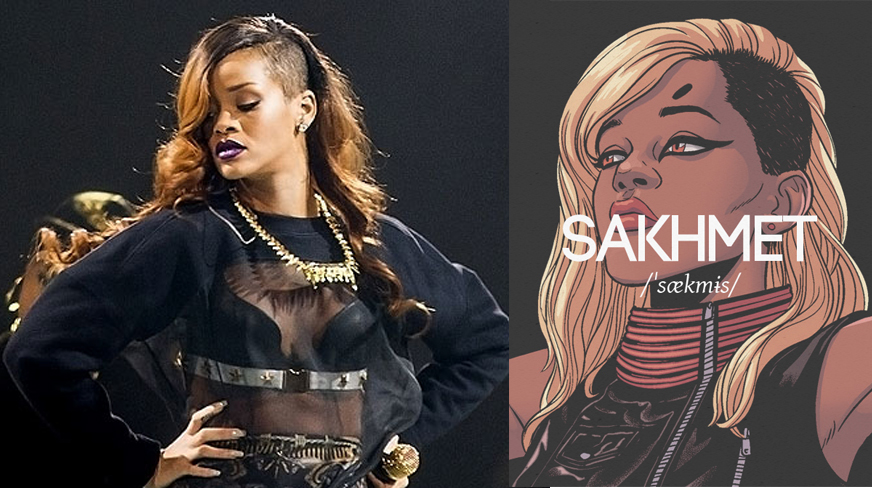
Insatiable, rebellious, and constantly under the influence, Sakhmet is pure fun.
Casting Choice: Assuming money isn’t an issue, there’s no need to fix what isn’t broken since the wild and insatiable Sakhmet is already based on popular songstress, Rihanna.
Ananke
Matriarch supreme Ananke commands your attention, and as the only immortal not to be reincarnated every cycle, I think she is quite possibly the most interesting character in the series thus far.
Casting Choice: Watching the Dame Judi Dench scold anyone leaves an impression, and she’s one of the few people I’ve watched who can make a whisper seem menacing.
Baphomet
Black leather, abs, fangs, and perfectly tousled hair make up the bad boy, Baphomet, but there’s definitely more than meets the eye. Easily one of the more fun members of the Pantheon, his character provides room for puns, lots of dramatic flair, and a healthy dose of flirtatious dialogue
Casting Choice: As there’s “none more goth” than he, except perhaps The Morrigan, Baphomet requires a brooding actor who could definitely fill the shoes of the rock star celestial being, like Game of Thrones’ Kit Harrington or Teen Wolf‘s Tyler Hoechlin.
The Morrigan
It’s easy to pigeonhole The Morrigan (Badbe, Gentle Annie, Morrigan) as Baphomet’s lover and leave her there, but this three-in-one goddess has layers upon layers.
Casting Choice: Kaya Scodelario, Alexandra Daddario, and Anna Popplewell as a collective, or on their own, possess the vulnerability and ferocity of the Irish goddess(es) needed to accurately bring her to life.The Morrigan’s shapeshifting skills could also provide an easy explanation for the different faces, should the show cast three different ladies as the Queen of the Underground.
Inanna
The moment Inanna was introduced into the comic series, my mind immediately connected the him o the character Felix Dawkins from the Canadian sci-fi television series, Orphan Black. Normally a goddess, his purple aesthetic and sweet nature makes for a touching addition among the more rough members.
Casting Choice: Looks aside, Jordan Gavaris has proven himself proficient at portraying a complex character in a television series, and if someone with casting abilities hears my shouts on the internet, perhaps we can see him play this Prince-ly role.
Mentions of Tara were hard to come by in the first two arcs, but writer Kieron Gillen delivered one hell of a message when we got a whole issue dedicated to her, a message I hope will translate to television. I am loathe to say more about this casting, if only because we have so little of Tara to go on, and I don’t wish to spoil anyone!!
Casting Choice: Since Tara does not speak much outloud and her story revolves around her beauty, I chose gorgeous model/actress Shay Mitchell, probably best known for her work on Pretty Little Liars.
Since I have yet to cast Minerva, Woden, Dionysus, or Urdr/The Norn, tweet me your choices using the hashtag #SCFancastFriday!
Marjorie Liu wastes no time in building a diverse world, one rich in lore, and rife with struggles that echo real life war torn lands. Thematically, this is a story of survival for Maika and any companions she picks up on her journey.
In an interview with TheNerdsofColor, Liu describes some of her inspiration:
For a long time, I’ve always been thinking about what does it take to survive a cataclysmic war? What does it take to put yourself back together again after surviving something that horrific?
If Maika is any indication, you don’t put yourself back together fully, as shown by the yet unexplained missing appendage of our beautiful, yet fierce protagonist.
There is a delightful contrast between the charming cherubic faces of the small hybrid creatures, like the fox girl, Kippa, and the gore-filled violence of Monstress. In a setting where those in power are women, Liu takes care to provide a distinct voice for each of them, showing the facets of their personalities. So far, some of these characters are the monsters.
The project’s massiveness took Liu by surprise, and she told The Hollywood Reporter:
“I wanted to write about girls and monsters, which has been a theme of mine from almost the start of my career — girls and giant monsters, and the supernatural. I wanted to tell a story about war, and surviving war — and I wanted to set it all in an alternate Asia.”
Monstress certainly fulfills those requirements and without falling into popular tropes. Maika is definitely not the Asian Other, an exotic male fantasy for the rescuing, nor is she another Strong Female Character on her way to being someone else’s love interest or sidekick; there’s more to her than what we see in this first issue, and it’ll be an exciting journey with Liu and Sana Takeda at the helm.
Sana Takeda’s art is reminiscent of Japanese illustrator Yoshitaka Amano fantasy work, but where Takeda shines is in her incredible detail. From the get-go, this comic was on my radar thanks to that eye-catching cover, and allow me to say that the interiors and colors are equally beautiful. Sana Takeda does every bit of artistry in this book, from cover to color, and her attention pays off in a big way. Earthy tones provide excellent juxtaposition to flashes of bright color due to magic, or rivers of gold from clothing or metalwork, helping to create the vivid, steampunk infused Eastern flavor that helps make Liu’s story work.
Takeda also proves adept at bringing Liu’s disabled Asian female character to life, whom at no point comes across as weak, even as her first appearance is naked, yet defiant, as she is sold at auction. Maika’s powers aren’t the only thing magical in this book, if this first issue is any indication of Takeda’s talents. The final flashback panels in particular are haunting and unforgettable, as was the section below during Maika’s imprisonment.
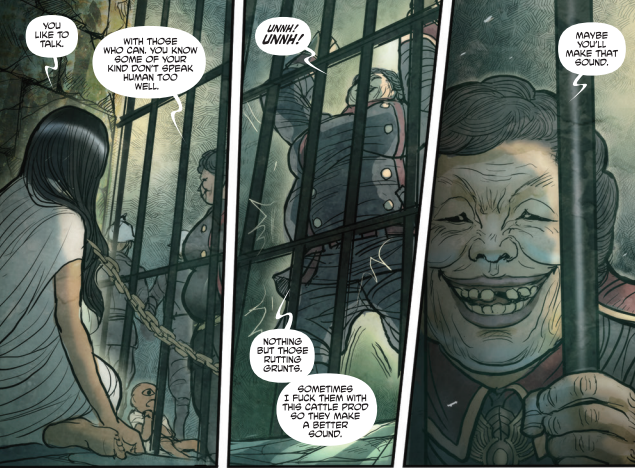
If I had one criticism about the book overall, it’s that it might not be for people unwilling to stick with the slow burn Liu has crafted. At a whopping 66 pages of gorgeous content though, it’s a minor complaint for such an exquisite read.
At the end of the day, this is a comic worth purchasing and adding to your collection, but please note, this is a comic aimed at mature readers for some graphic content!
Breaking into comics is hard, but publishing your first ever effort at Image, the same home of legends like Robert Kirkman and Jason Aaron, is an accomplishment that may have needed a little divine inspiration. We were incredibly thrilled to be able to talk to the creators of Saints, the brand new book from newcomers to the industry. Writer Sean Lewis and artist Benjamin Mackey proved to us that they were the only team that could have possibly created this book and discuss a newbie’s perspective of the comic industry. Check out the end of the interview to see how you can score a signed copy of Saints #1.
SC: Saints opens back stage at a concert, can you talk a little about the music you both like and how it influences your work?
Ben: For me, I like a lot of bands that deal with religious undertones like Sufjan Stevens or Me Without You. They have these really great pseudo religious narratives where they’re not really clear as to whether or not they have “faith” in their religions. It’s kind of like they’re just constantly questioning things. It’s maybe not so much like there’s a direct influence, but there’s a mentality that this music has of being in this constant state of questioning and pealing back the layers behind religion. That’s something that I like to implement in the book in some way.
Sean: Well I grew up with an uncle who was in a death metal band and we lived in the same house together. I thought he was super cool so I used to go through his record collections all the time. Old school metal has always been something that has been present. I’m also a huge hip hop fan. I usually get drawn to musical styles that have some level of narrative storytelling. A lot of metal has weird Dungeons and Dragons lyrics in it and a lot of the urban lyrics of hip hop music does too. I like a lot of music that changes style and moves around. I listen to a lot of Death Heaven right now and a lot of this rapper named EL-P and Run the Jewels. So things where the dynamic shifts constantly, whether in music or in literature; those are like some of the biggest influences on me. Where you’re watching something where it’s really funny, and then you’re crying, and then it’s dark, and then it’s light. It feels more like life to me, so even the music that I listen to is a lot like that. I would encourage people to get the new Death Heaven; it’s excellent.
SC: My[Kaitlyn] Confirmation name is actually Lucy, which I chose because that is the name of a character in The Chronicles of Narnia. We’re sure that a lot more purposeful decision making went into which saints would be included in your book. Can you talk a little about the research that went into these characters?
Sean: Ha, well my confirmation name is Blaise (the first saint that we meet in the book). The original idea from the book is from Ben. He had been pretty obsessed with the saints.
Ben: So in college I was a painting major and I took a before-1400 art history class, and that got me really interested in western art history, which further solidified into medieval art and early Renaissance history. During those time periods you are just inundated with saints and you can’t escape them because they permeate art for hundreds of years. I studied abroad in Italy for half a year and that was even more full of constant saint exposure. They’ve taken on these iconic super-heroic proportions. I started thinking of about “Oh, what if these saints use their symbols and martyrdoms to inspire their super powers.” So St. Sebastian, for example, was martyred by a hail of arrows, so it became “Oh, what if he can grow these arrows out of his chest and then fire them at people?” Or maybe St. Lucy, because she lost her eyes, maybe she could have this saintly vision and extra-perception that she can tap into.
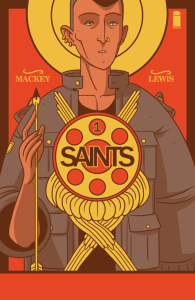 SC: Seems like a logical path of inspiration to us. We should take a moment to congratulate you both on publishing your first issue of your first comic ever! Issue #1 a solid opening for sure. How did you break into the industry?
SC: Seems like a logical path of inspiration to us. We should take a moment to congratulate you both on publishing your first issue of your first comic ever! Issue #1 a solid opening for sure. How did you break into the industry?
Sean: It was kind of crazy and fast. Ben and I only met a year ago and we started talking and this idea came together. Basically we put the book together in about six months and we sent a pdf to Eric Stephenson, the CEO at Image…and he decided to do it.
SC: That’s incredible!
Sean: Ha, I don’t think it’s the typical story. We did a signing with some of the other Image creators the other day who asked how we got in. When I said, “Oh, well we just sent in a pdf,” they were like, “No, seriously, how did you get them to read it?” I don’t know. The timing, I guess, must have been good, but it was very fast. We sent it in, I don’t think expecting-
Ben: It was like our pie-in-the-sky
Sean: Yeah. It was like our reach school for college. You know, we sent off our SATs to reach school and prepared to look at others that we were probably going to be at.
SC: What made you guys choose Image?
Sean: I grew up reading comics but went away for a little bit until I got really obsessed with Jeff Lemire. I read Essex County and that was what brought me back into comics. When I heard that he was writing some books for Image, that brought me over to looking at some of their other work. I started picking up Saga and Southern Bastards. Working on this book, I started reading some more Image books and noticed that they’re doing some really intricate character stories and ours is definitely a weird character story. So then it just seemed like the right fit.
Ben: I didn’t really start reading comics until 6th grade when I started with the typical Marvel and DC books. Then I read Invincible from Robert Kirkman and Ryan Ottley and that totally switched my view of how you can make comics. It was so different and more real than Marvel and DC ones. That led me into all these other Image titles. Image has been one of my favorite comic book publisher every since then.
SC: We definitely think that once people expand their reading beyond what Marvel and DC has to offer, they realize that comics encompasses a huge world with a lot of variety.
Sean: I’m kind of amazed walking around [at NYCC]. I had no idea the breath of independent publishing and how many companies that there are.
SC: Going back to Saints. Will you be incorporating other beliefs and faiths into your story?
Ben: Yeah.
SC: “Yeah” is a perfectly succinct and clear answer.
Sean: Ha, well without going to deeply into it, that’s been a big conversation.
Ben: Even the stranger aspects of Catholic mythology. But we’ll be getting into Zoroastrianism and Gnostic Christianity and occult Christianity.
SC:Have you gotten any backlash from depicting certain aspects of Christianity?
Sean: Well the book only came out two days ago. My grandparents are constantly asking me about it. But in some ways that would be interesting because it would lead to some interesting conversations. Just in the sense, for me at least, religion is this fascinating thing that, whether you are religious or not, is such a huge informant on your life. So many laws and wars that people we know go off and fight are centered around religion. It’s this thing that, whether we want it to be or not, is part of our every day life. I think that there is so much room that if people were to get upset, I’d be like “good, let’s actually talk about it instead of being like ‘Well, I believe it and you don’t’ or ‘I think you’re crazy and you believe in fairy tales so I’m not going to deal with you.'” I’m curious about where you can get those pictures of faiths.
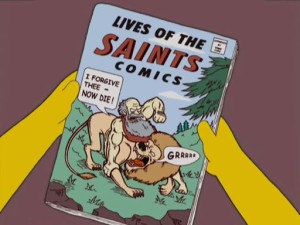 My grandmother is insanely devout and I think sadly thinks that this is going to get taught in Sunday school. Her son is a pretty militant atheist. For me, those are the heavily influences within my house.
My grandmother is insanely devout and I think sadly thinks that this is going to get taught in Sunday school. Her son is a pretty militant atheist. For me, those are the heavily influences within my house.
SC: So this book is Christmas dinner.
Sean: This book is like every Friday night.
SC: Ha, well moving from family dynamics to your working relationship. Do you provide a really strict script to Ben, or does he have free reign to interpret your words?
Sean: Not too strict. I think we’re learning that not a lot of people create the book the way we do. I come from a fiction and playwriting background. So Ben and I break the story down together. So we discuss that “Oh, Sebastian and Lucy will end up here” and then for each issue I go and write like a 3000 word short story, like a really vivid Flannery O’Connor type short story. I send it to Ben and he adapts it into the panels. Then I don’t start writing language or narration until Ben gives me the panels back. It allows us both to really own the world. I get to give him emotionally where I think the scene was or how things were happening and how the characters live and behave, but then I get to see visually where the camera angles are. So I get to really interact with what he’s drawing.
Ben: It’s been great. Having the short story to work with, I get filled with so much more than what a basic script would give me. I’m filled with these emotions and tones that would seem sort of distant in a script. They inform color pallets and how characters would carry themselves and expressions. A lot of the subtle undertones come through by working with the short story that Sean gives me.
Sean: And vice versa. It does two things. A 3000 word short story would be like a really long comic book. So some of the editing naturally happens. The pacing gets better and tighter from what Ben has done. Some of the angles or panel breakdowns help me realize that “Oh, I only need these things” because it’s so much more clear. It’s been a nice give and take on that way of finding the book in that trade.
SC: What about the character designs? Did you collaborate on those?
Sean: We talked about what we thought they would look like.
Ben: We were always on the same boat. I think that we had the same idea about who a character is. I would come with a sketch and Sean would be like “that’s what I was thinking!”
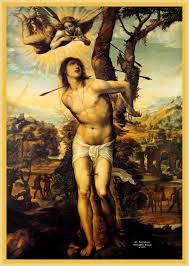 SC: So Sebastian rocking the traditionally “Jesus look” was discussed and premeditated?
SC: So Sebastian rocking the traditionally “Jesus look” was discussed and premeditated?
Ben: Well for Sebastian, his design has a historical precedence. If you look at paintings of St. Sebastian, he looks a lot like that. Over the years he’s turned into this gay icon. That was something that we wanted to reflect in the popular culture that’s been assumed around his precedence and bring that into the comic book world.
SC: Since you are both newcomers to the industry, we’re wondering if you have come across a “club mentality?” Do you feel on the fringe?
Sean: So far people have been really cool. We were just talking about that. Even other companies have been so supportive. The people that we’ve met at Image have been really lovely. To be honest, I haven’t met a ton of other creators yet, but the ones that we have had been really inviting.
I work primarily in theater, which sometimes has a collegiate atmosphere, but there definitely can be some club mentality. I’ve found the comic world a bit more supportive, overall. Just in terms that I’ve been surprised how much other publishers have told us that they hope our book does well.
SC: Leave the competition to DC and Marvel.
Sean: Which seems so smart. There’s been a lot of mentality that, well if you guys do well, we all kind of do well, which is so nice to hear. I’m used to it being like “well, your show is opening against our show, so I hope your show dies.”
SC: As far as the big two are concerned, do you have a dream project that you’d ever do?
Sean: Right now Saints feels like a dream. We met doing a play, so we’d be painting the set while talking about this. So the idea that it went from that to we’re here at Comic Con is insane.
SC: Is this your first convention?
Ben: Oh, yeah.
SC: You guys started big. Have you been able to walk around at all?
Sean: They told us it was big, I didn’t know what that meant I guess. Thursday I was here and able to. Today’s been really overwhelming.
*It should be noted that Ben and Sean were talking to us at the Image booth where Robert Kirkman was doing a signing across from the Marvel stage where, at the same time, the Daredevil cast was trotting out and also next to Viz Media where Naruto dominating the Con . It was the nexus of hell.
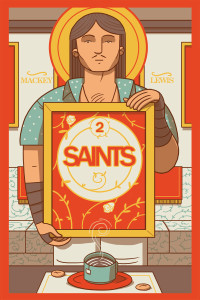
SC: Ok! So tell us about Saints! What can we expect in issues to come?
Ben: I think right now there’s still a lot of world building that we’re doing. We’re starting to see these dreams in the first issue that are cryptic and mysterious. We’re going to see those starting to have more grounding in what’s going on in the plot. You’re gonna see a lot more growing of the characters and interactions with one another and how they relate.
Sean: Plus the growth of the threat. One of the things that you were asking about with faith, you’ll start to see emissaries of other breakdowns of Christianity first. What they want to use the saints for or what they want to do to the saints starts to become really apparent. That’s coming up really soon and heading toward some big face-offs.
SC: We were really interested in your diverse cast. Blaise is half-Irish/half-Mexican and Sebastian is, as you mentioned, a gay icon.
Sean: It’s funny. I was just talking to some people at another booth and they mentioned the same thing. Maybe it’s coming from theater, but it wasn’t really a choice. It just feels like the world to me. You look around Comic Con right now, and that’s all you’re seeing. I’m glad people are responding to that, but I didn’t expect it to be something that would even be a noticeable entity in the book.
SC: Are you familiar with the #lighten up story by colorist Robert Wimberly concerning editorial notes to lighten the skin tone of a mixed-race character? Welcome to the industry, we guess.
Ben: Yes, I read that story.
Sean: So there’s almost like a literal white-washing of characters. In theater, especially, but I guess this is always a conversation. In comics, is there more of a championing for representation and diversity?
SC: Oh, for sure. You’ve entered the industry at a really interesting time. It’s a really good time for a book like Saints to come out.
Ben: I’m just happy because I’m a nerd about saints and that’s like a weird thing to be. I didn’t think anyone was going to like saints as much as I do.
SC: Ha, well that might be true, but I think you’re getting some of us there.
Ben: Ha, well I think Sean has made it more approachable and getting people to nerd-out about saints.
Sean: It’s been helping me deal with Catholic school in a whole different way.
Me too, Sean. Me too.
We want to thank Ben and Sean for taking the time to talk to us and for signing a copy of Saints #1 for us to give away! For a chance to win, follow @SAINTScomic and send them a tweet to let them know @sub-cultured sent you! Saints #2 will be out November 4th.
Kaitlyn D
Content Editor
Amidst the flurry of panels and people that is New York Comic Con, we carved out time to speak with several creators, including one of our faves, Justin Jordan (John Flood, Dark Gods, Luther Strode). His table was nestled between other notable creators, and littered with merchandise from his Walking Dead meets The Thing title, Spread. I was lucky enough to sneak him away for a few minutes to discuss his projects, and the industry!
SC: Let’s start with the easy ones. What are you currently reading?
JJ: Ah, what am I currently reading? Wicked + Divine…It’s going to look like a whole list of Image stuff. It’s going to be Wicked+Divine, East of West, Bitch Planet, um, I just read Diesel from Boom! or Archaia, I don’t remember which it is, it’s one of them, but it was very cool. I liked that a lot. There was something from Marvel I really liked a lot….oh, it was Weirdworld!
SC: Weirdworld was definitely different, haha. Do you have a character trope you would like to put your own twist on, like for instance, is No (a character from Justin’s creator owned work from Image, Spread) actually a hero on a heroes journey?
JJ: -laughs- No’s journey is not actually a hero’s journey per se. He is a hero, but the journey he is going through is not the Campbellian kind of thing. Like, yeah I mean, I like to do that in general, but there are a lot of characters that I think I could do interesting stuff with like that. Things that’d be good with like, Kingpin from Marvel and stuff and I would like DC to let me do a Bane comic, cause I think there are ideas to do with those characters that I’ve never seen done that are still true to the central core of the character.
SC: Do you think you write better in the mini-series format or on ongoing ventures? Is there more freedom doing ongoing, or…?
JJ: I don’t know about freedom, but there are struggles that go on. One of the few things I am still not happy with me as a writer is that in an ongoing format is making sure the flow is there. When I’m working with just six issues, I can get everything planned out fairly precisely in a way that satisfies me, but the ongoing, it’s a bit softer. I know that probably isn’t bad for the reader, but as a writer it’s not what I’d want it to be.
SC: For those of us who follow you on social media, your comic making, back end/”how the sausage is made” posts have been enjoyable and informative. Have you thought about doing that as a blog?
JJ: I could do that. I don’t know that there’s enough stuff there, you know what I mean? I don’t know how much I can get out of doing it, which is why I just post things. I want to do more of them as I think about them.
SC: They’re interesting! From a retailer’s perspective, we don’t get to see that part of comics, so it’s helpful, even. For instance, your $9.99 trade post in particular, was eye opening.
JJ: I was actually talking to someone earlier about that. That in particular though, the dynamics of pricing and your audience and stuff is something that if I wanted to go into detail about it, I could tell you about it for hours. There’s so many variables, right? It’s hard, because you’re essentially winging it on them [the trades].
SC: What can you tell us about “the comic formerly known as Crawl”?
JJ: Well, I’ve got an art team on it, and we have some of the character stuff. My intention right now, as we are at NYCC, is to …I’ve done a twelve page preview of it, which is also going to serve as the pitch, but what it actually is, is part of the backstory to the actual book itself. It takes place about ten years before what is going on in the book. I’m pretty sure when the book is greenlit, and if I’m allowed to do so, I intend to release that for free online, before the book comes out. By design it is meant to show you what the book is about. It has all the elements, and then, if that happens, it will also run as back matter in the book itself. That way you don’t have to go online to get it.
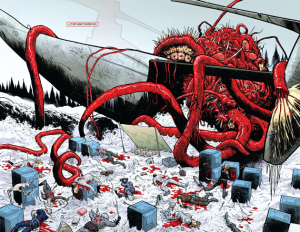 SC: Back to Spread real quick. Is that your first foray into the genre of body horror?
SC: Back to Spread real quick. Is that your first foray into the genre of body horror?
JJ: I mean yeah, you can probably argue that Luther Strode has some body horror in it, given how grotesquely people explode in that. But…yeah, I like body horror a lot. I am as anybody who has read Spread will probably know, I am a big fan of John Carpenter’s The Thing, but there’s also stuff like in Japan, like Uzumaki, Parasyte, and fucked up 80’s horror movies like Society, I don’t know if you’ve seen it.
SC: NO. Definitely going to add it to my giant list of stuff to watch, though! Is there something you’re terrified to touch, horror wise, or would you consider yourself desensitized?
JJ: I don’t know that I’m desensitized. I do know there’s some stuff harder for me than others…I was going to say it’s a weird fear, but I’ve got a thing for amputation. An amputation phobia, probably because I’m diabetic, so that’s a thing that’s on my mind. Anything with losing limbs tends to get me, but I do still put it in my books, but it is a thing that personally wigs me out. There is stuff in Spread, not necessarily body horror, but in issue 12 which is out in January, it’s Molly’s story. There’s some experiences that she has had that I found genuinely hard to write. It’d get to a point where I was like, alright I need to walk away from this for a moment. Teeth shit also bothers me.
SC: You’ve worked with several artists over and over again, do you tend to give them free reign when they get your scripts? Are you more of a strict outline kind of guy?
JJ: My general policy is … I write full scripts but I rarely, very rarely have a strict panel outline in mind, for instance. I will tell them, these story beats need to happen, but even then if there’s something that doesn’t need to happen, then I’ll have them tell me. If they want to add panels, or change the panel rhythm, that’s all cool cause artists have a better sense of laying out a page visually than I do. That’s the fun part of comics.
SC: Right now, comic diversity is a major thing. Will you be creating a character in the future who doesn’t necessarily fit the mold?
JJ: Well, No is a half Korean gay man, so yes! No, I do and by design, I don’t advertise it, except obviously for this interview. It has to be the right person for the book, but in as much as I can, I work with…I wanted to work with a woman who wasn’t American, who wasn’t white, so for Deep State, I worked with Ariela Kristantina. For Crawl, the art team is all from the Phillipines, and half of them is women. I’m trying to work with a more diverse group of creators. Not just because I think there needs to be more diversity in the industry, but because it ends up with a fresher, better product. As a white whitey white white guy, I think that adds some creativity to something that didn’t have that in the beginning.
Spread is currently out in trade paperback form (it is gory, but fantastic), as is The Strange Talent of Luther Strode, The Legend of Luther Strode, and Deep State! Stay tuned for other interviews from the NYCC floor!
Leia Calderon
Editor
@ladyvader99
After our conversation with Cuban writer Ivan Brandon (Drifter) at New York Comic Con, we felt a push to highlight some more Hispanic comic creators and artists during the last days of Hispanic Heritage Month (September 15- October 15). Check out if your favorite artists made the list below as well as in part 1 and part 2 and be pleased as we were to note that most of them sit at the top of our lists of favorite artists of all time.
Raphael Albuquerque
This talented Brazilian artist is best known for his work on Blue Beetle and as the co-creator with Scott Snyder of American Vampire, which won the Eisner Award for best new series in 2011.
Gustavo Duarte
This Brazilian cartoonist and illustrator is currently working on DC’s adorable Bizarro with Heath Corson. His previous works have been collected and published by Dark Horse.
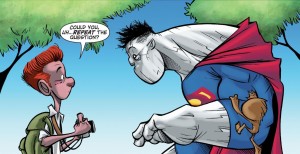
Phil Jimenez
This openly gay half Irish-half Mexican American artist is known for his LGTBQ advocacy as well as his award-winning tenure in the industry. He is loved for his collaborations with Grant Morrison (New X-Men, The Invisibles) as well as his run on Wonder Woman.
Kenneth Rocafort
This Puerto Rican artist has been beautifying and sparking controversy in the pages DC comics with his work on Red Hood and the Outlaws and Teen Titans. His work has been consistently unique and gorgeous since his days on Wolverine/Punisher and Madam Mirage.
Alvaro Lopez
Inkers never get enough love from comic fans, so we decided to mention this prolific Spanish artist who has worked on both Marvel, DC titles. 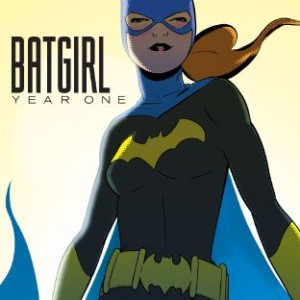
Edgar Delgado
In our interview with Ivan Brandon at NYCC, we commiserated on our inability to name any Hispanic colorists. Luckily, Brandon was able to save the day. This Mexican colorist has worked on Marvel titles including The Amazing Spider-Man and World War Hulks.
George Perez
This legendary Puerto Rican artist defined DC and Marvel comics in the 1970’s and 1980’s in the pages of Teen Titans, Avengers, and Wonder Woman.
Javier Rodriguez
This Spanish illustrator and colorist is best known for his lovely work on Batgirl: Year One and The Amazing Spider-Man and Daredevil.
Quick, push us to compose a pt 4 before Hispanic Heritage Month ends on October 15th! Shout out your favorite Hispanic Artists in the comments below.
Kaitlyn D
Content Editor
@deadrabbit92


